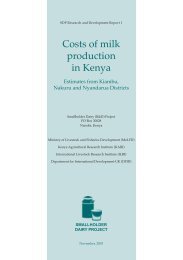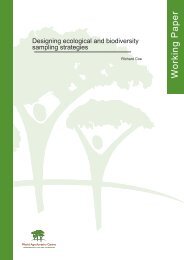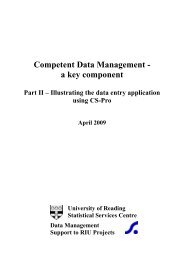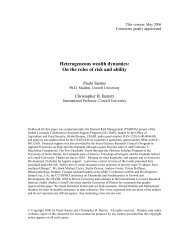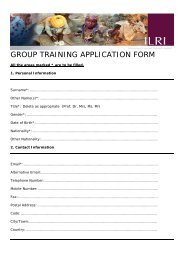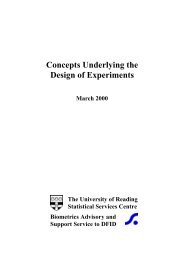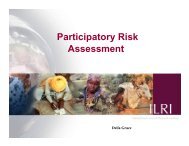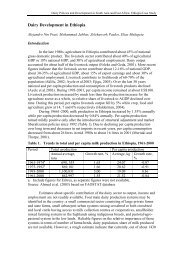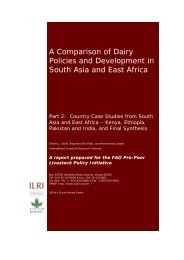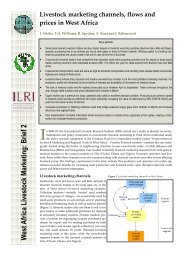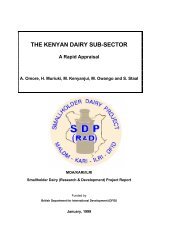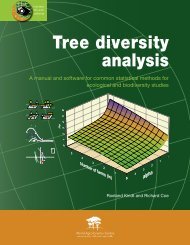Improvement of Livestock Production in Crop-Animal Systems in ...
Improvement of Livestock Production in Crop-Animal Systems in ...
Improvement of Livestock Production in Crop-Animal Systems in ...
You also want an ePaper? Increase the reach of your titles
YUMPU automatically turns print PDFs into web optimized ePapers that Google loves.
prevention, control and eradication <strong>of</strong> epidemic diseases, so Indonesia and the Visayas and M<strong>in</strong>danao islandgroups <strong>in</strong> the Philipp<strong>in</strong>es are free from foot-and-mouth disease. Other diseases that have occurred <strong>in</strong> thesub-region <strong>in</strong>clude anthrax, trypanosomiasis, malignant catarrhal fever and those caused by various parasites.In small rum<strong>in</strong>ants, gastro<strong>in</strong>test<strong>in</strong>al roundworms (nematodes) and flatworms (flukes) are the most importantcauses <strong>of</strong> health problems. Diseases recorded <strong>in</strong> the ASEAN sub-region and the Lao PDR are given byCampbell (1992).Sw<strong>in</strong>e fever is the most important disease for pigs and Newcastle disease for poultry. The latter is usuallymore <strong>of</strong> a problem <strong>in</strong> commercial flocks where large numbers <strong>of</strong> birds are kept <strong>in</strong> close proximity to eachother <strong>in</strong> <strong>in</strong>tensive systems. Nevertheless, mortality rates can also be high <strong>in</strong> unvacc<strong>in</strong>ated birds <strong>in</strong> scavengersystems, as was observed <strong>in</strong> the transmigration areas <strong>of</strong> south Sumatera, Indonesia.Access to available veter<strong>in</strong>ary services by small farmers was relatively good <strong>in</strong> the four countries <strong>of</strong> theASEAN sub-region and <strong>in</strong> South Ch<strong>in</strong>a. On the other hand, as mentioned above, veter<strong>in</strong>ary delivery systems<strong>in</strong> the Mekong countries were poor and a major constra<strong>in</strong>t to animal production. In Indonesia and thePhilipp<strong>in</strong>es, traditional medic<strong>in</strong>es such as papaya products are sometimes used by smallholders for thetreatment <strong>of</strong> <strong>in</strong>ternal parasites <strong>in</strong> goats. In the Philipp<strong>in</strong>es some 35 plants have been used by farmers to treatsick animals <strong>in</strong> village situations.There is considerable evidence that <strong>in</strong>digenous animals are more resistant to diseases than exotic breeds,although poor nutrition and management may underm<strong>in</strong>e this trait. For example, Malaysian Kedah-Kelantancattle and Yellow cattle (synonymous to the Kedah-Kelantan) are resistant to many tick-borne diseases, whilstIndonesian Th<strong>in</strong>-tailed sheep, Thai Longtail sheep and Malaysian Katjang goats are resistant to many <strong>in</strong>ternalparasites. Malaysian Kampong chicken are known to be resistant to Newcastle disease.Socio-economic aspects and policySocio-economic studies on mixed farm<strong>in</strong>g systems <strong>in</strong> the Mekong countries are essentially non-existent.Hence, experiences have been drawn primarily from the ASEAN sub-region where such studies exist. Table10 summarises the key socio-economic constra<strong>in</strong>ts affect<strong>in</strong>g small farmers <strong>in</strong> the ASEAN sub-region, andgives an <strong>in</strong>dication <strong>of</strong> commonalities as well as the differences between the countries.Labour and mechanisationThe opportunity cost <strong>of</strong> labour is <strong>in</strong>creas<strong>in</strong>g at a rapid rate <strong>in</strong> Malaysia and Thailand. This has affected andwill cont<strong>in</strong>ue to affect crop–animal <strong>in</strong>tegration <strong>in</strong> these countries. In Malaysia, the most <strong>in</strong>dustrialised country,labour is a serious constra<strong>in</strong>t to the promotion <strong>of</strong> animal production <strong>in</strong> rubber and oil palm plantations. Thisis particularly true <strong>in</strong> the corporate plantations which depend significantly on hired migrant labour from theIndian sub-cont<strong>in</strong>ent. Thailand, because <strong>of</strong> its relatively high annual rate <strong>of</strong> economic growth (averag<strong>in</strong>gclose to 8% dur<strong>in</strong>g the last 10 years), is also experienc<strong>in</strong>g labour shortages <strong>in</strong> the rural areas. This has resulted<strong>in</strong> a rapid <strong>in</strong>crease <strong>in</strong> the mechanisation <strong>of</strong> farm operations, with a correspond<strong>in</strong>g decl<strong>in</strong>e <strong>in</strong> the use <strong>of</strong> animalsfor draft purposes. The exception to this is <strong>in</strong> the north-east <strong>of</strong> the country, where the population <strong>of</strong> buffaloeshas rema<strong>in</strong>ed relatively stable over the last 10 years.Land area and tenureLand area is a serious constra<strong>in</strong>t <strong>in</strong> the Philipp<strong>in</strong>es because the country has the highest population density. Thereis also a high rate <strong>of</strong> land conversion from agriculture to non-agricultural activities. The result <strong>of</strong> this developmenthas been a decl<strong>in</strong>e <strong>in</strong> certa<strong>in</strong> regions <strong>in</strong> the areas <strong>of</strong> grassland for large rum<strong>in</strong>ants, e.g. <strong>in</strong> the <strong>in</strong>dustrialised parts<strong>of</strong> the Luzon island group. In the M<strong>in</strong>danao island group, where population density is low, land area is not sucha serious problem. In the other countries limitations on land area are a less severe problem.In the Philipp<strong>in</strong>es, land tenure is also a major constra<strong>in</strong>t and the land reform programme has not mademuch headway. This has curtailed the <strong>in</strong>centives for smallholders to <strong>in</strong>troduce improvements <strong>in</strong>to theirfarm<strong>in</strong>g operations (e.g. sow<strong>in</strong>g <strong>of</strong> improved pastures under perennial tree crops). Often, tenants are preventedby the landowners from <strong>in</strong>troduc<strong>in</strong>g such improvements s<strong>in</strong>ce these could serve as legal bases for tenure



